Tangible Cultural Properties of Gyeonggi-do No. 100
Ononsa Guesthouse
- Address
- 58 Gwanaksan-gil, Gwacheon-si
- Directions
- Exit 7, Gwacheon Station 5-minute walk (opposite Gwacheon Elementary School)
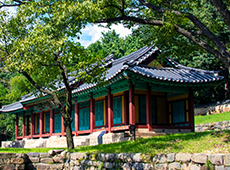
Tangible Cultural Properties of Gyeonggi-do No. 100
Ononsa Guesthouse
Ononsa Guesthouse is the main building of gaeksa that was attached to
a government office of Gwacheon-hyeon during the Joseon Dynasty.
Gaeksa was an official residence installed in each town, and was used
as a lodging for officials traveling in the provinces.
Gaeksa
in Gwacheon was built in the 27th year of King Injo (1649) by
Governor Yeo Yihong, who built dongheon (magistrate’s office), and,
later, seoheon (study room) was built by Nam Changjo in the 7th year
of King Hyeonjong (1666), so it is larger than other structures in
other regions. This is because the kings of the Joseon Dynasty had to
stay there while passing through Gwacheon when traveling south.
The name “Ononsa” was given when King Jeongjo stayed at the gaeksa in
Gwacheon, while he was making a royal visit to Hyeonrungwon, and gave
a signboard named “Ononsa (穩穩舍)” because “the surrounding scenery is
nice, and it is relaxing to rest there.” Dongheon was named
“Burimheon (富林軒)” after the old nickname, Burim.
During the
Japanese occupation, it was used as a government building in
Gwacheon-myeon due to the policy of eradicating national culture by
the Japanese, and, in 1932, the existing building was demolished, and
the original shape was changed. Then, in 1986, it was dismantled and
restored with the reference to the shape of Nagan Gaeksa in
Seungju-gun, Jeollanam-do.
The current Ononsa Guesthouse has a
9-room frontage with 3 main rooms and 3 consecutive rooms on the left
and the right, and a 2-room side and its shape, a gambrel roof, is
featured on the main room of a gambrel-roofed house.
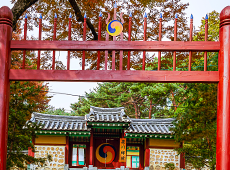
the Gyeonggi Cultural Heritage Material No. 9
Gwacheon Hyanggyo (Confucian Temple)
Hyanggyo is a public educational institution established in the
Joseon Dynasty, where the ancestral rites of Confucius and other
sages were held and local people were educated. If you were a yangmin
(citizen) or higher, you could attend the school
The study of
Custodianism, writing poetry and sentences, and the study of
Confucian classics, studying the scriptures and history of
Confucianism, were the main contents of education, and lectures were
given at Myeongnyundang Lecture Hall. There were dongjae ( 東齋 : for
the children of yangban (aristocrats)) and seojae (西齋 : for the
concubines sones and children of commoner), which are equivalent to
today’s dormitories.
Munmyo (文廟 : Daeseongjeon Shrine: Confucian shrine) serves the
ancestral tables of the Five Sages of China, including Confucius, Yan
Hui, Zisi, Zengzi and Mencius, the two disciples of Confucius,
including Zhu Xi and Cheng Hao, and 18 Sages of the East, including
Seol Chong, Choe Chiwon, An Yu, Jeong Mong-ju, Jeong Yeo Chang, Kim
Gwingpil, Jo Gwangjo, Yi Eonjeok, Yi Hwang, Kim Inhoo, Yi I, Seong
Hon, Gim Jangsaeng, Jo Heon, Gim Jip, Song Si-yeol, Song Jun-gil, and
Pak Se-ch’ae. On the first day of the spring (February in the lunar
calendar) and the autumn (August in the lunar calendar), Seokjeonje
(釋奠祭 : the semiannual services in the honor of Confucius) is held,
and Bunhyangrye (焚香禮 : memorial service) is held on the first day and
the fifteenth day of every month.
Gwacheon Hyanggyo is said to be built in the 7th year of King
Taejo (1398). Its original Location was at 2 ri northeast of gwana
(government office), Gwacheon, but it was moved to its present
Location west of gwana in the 16th year of King Sukjong (1690). In
1959, it was used as Siheung Hyanggyo, according to the military name
of Siheung-gun, and, in 1996, it was changed to its original name,
Gwacheon Hyanggyo.
The current hyanggyo buildings were repaired
in September 1975, with Myeongnyundang, an educational space, in the
front, and Daeseongjeon, a space for ancestral rites, in the back, so
it was built with a study space in front, and a memorial service
space in the back. Daeseongjeon is an ikkong-style building with a
3-room frontage and a 2-room side. There is a poongpan (gable board)
on a gabled roof and double eaves. Myeongnyundang, which originally
had a 3-room frontage and a 2-room side, has additional rooms on the
left and the right sides. Oesammoon (outer three gates) is a
sotuldaemun (tall gate) style with a 5-space frontage and a 2-space
side, built in 1974, and there is a hongsalmun (a red gate with
spiked top) built in front of an eosammun.
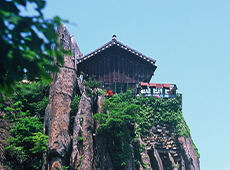
the Gyeonggi-do Monument No. 20
Yeonjudae
Yeonjudae refers to the place where Nahanjeon Hall (Eungjinjeon Hall:
應眞殿) was built by piling a 30 m-long shaft in the gap between the
rising rocks of Yeonjubong Peak in Gwanaksan Mountain Peak. It is a
small hermitage built by Great Master Uisang in the 17th year of King
Munmu of Silla (677), and it is said that it was originally called
Uisangdae.
There are two theories as to why Uisangdae was
called the present-day Yeonjudae. One, after the founding of the
Joseon Dynasty and the capital moved from Kaesong to Hanyang, the
people who missed Goryeo came up here, and missed the old dynasty.
Another theory is when Taejong tried to appoint the third prince,
Chungnyeong (Sejong) as the crown prince, his two older brothers,
Prince Yangnyeong and Prince Hyoryeong, left the palace and stayed
here..
Eungjinjeon is called Nahanjeon because Monk Kim Wansong
enshrined 16 nahans (Buddha’s disciples) during the reign of King
Cheoljong. There are three sacred images of Buddha, which appeared to
be modern works. At the entrance of Eungjinjeon, a standing statue of
Yaksa Yeorae (Healing Buddha), which is said to heal people’s
diseases and give Buddhistic teaching, is enshrined in the
rock-carved sanctuary on a hipped roof with a medicine bottle on her
left hand and showing abhara-mudra on her right hand. It is presumed
to be created during the Goryeo Dynasty (constructed by King
Hyoryeong according to the repairing record of Nahanjeon Hall). .
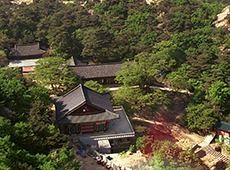
Yeonjuam Hermitage
It is a temple located on the south side of Yeonjubong Peak in Gwanaksan Mountain, and is famous as a prayer temple
where many people visit, praying for their child’s admission into university during the university entrance examination
season.
It is known to have been established by the Great Master Uisang during the Shilla period, and unlike the traditional
Buddhist temple architecture, it is unique as it has a two-story structure on a high stone pillar. It runs as a temple stay,
so visitors can experience life in a temple.
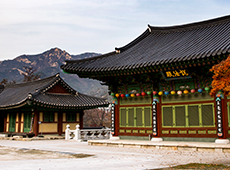
Bogwangsa Temple
It is a temple built in the center of the city, and is scattered with valuable cultural assets, such as Wooden Seated Buddha, Three-story Stone Pagoda from Munwon-ri, Standing Stone Buddha Sculpture of Munwon-ri Temple Site, etc.